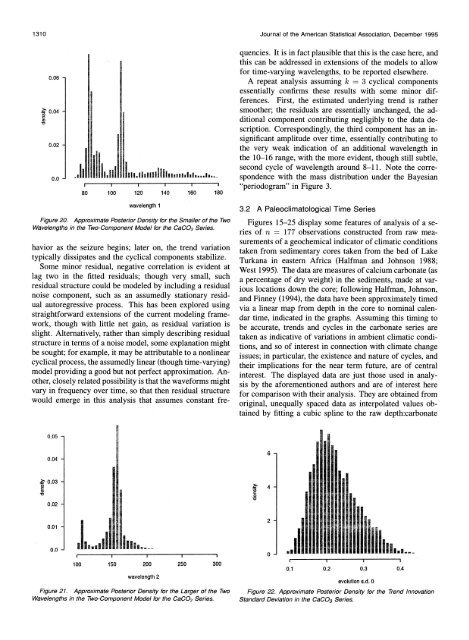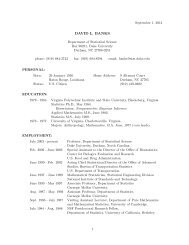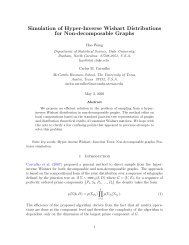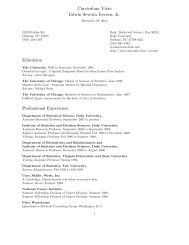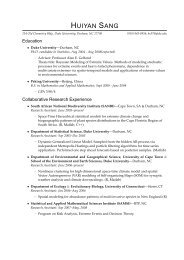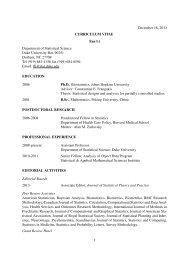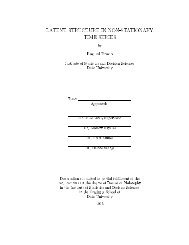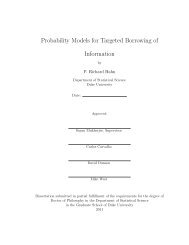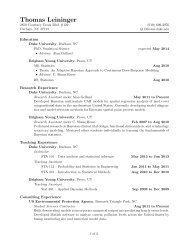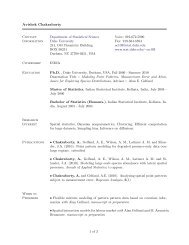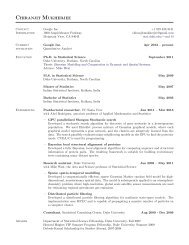Bayesian Inference in Cyclical Component Dynamic Linear Models
Bayesian Inference in Cyclical Component Dynamic Linear Models
Bayesian Inference in Cyclical Component Dynamic Linear Models
You also want an ePaper? Increase the reach of your titles
YUMPU automatically turns print PDFs into web optimized ePapers that Google loves.
1310 Journal of the American Statistical Association, December 1995<br />
0.06<br />
. 0.04 -<br />
2<br />
a)<br />
0.02-<br />
02 ,<br />
I 1;Il;<br />
i,iZXlllUIJII,,<br />
I<br />
80 100 120 140 160 180<br />
I,.<br />
quencies. It is <strong>in</strong> fact plausible that this is the case here, and<br />
this can be addressed <strong>in</strong> extensions of the models to allow<br />
for time-vary<strong>in</strong>g wavelengths, to be reported elsewhere.<br />
A repeat analysis assum<strong>in</strong>g k = 3 cyclical components<br />
essentially confirms these results with some m<strong>in</strong>or differences.<br />
First, the estimated underly<strong>in</strong>g trend is rather<br />
smoother; the residuals are essentially unchanged, the additional<br />
component contribut<strong>in</strong>g negligibly to the data description.<br />
Correspond<strong>in</strong>gly, the third component has an <strong>in</strong>significant<br />
amplitude over time, essentially contribut<strong>in</strong>g to<br />
the very weak <strong>in</strong>dication of an additional wavelength <strong>in</strong><br />
the 10-16 range, with the more evident, though still subtle,<br />
second cycle of wavelength around 8-11. Note the correspondence<br />
with the mass distribution under the <strong>Bayesian</strong><br />
"periodogram" <strong>in</strong> Figure 3.<br />
wavelength 1<br />
Figure 20. Approximate Posterior Density for the Smaller of the Two<br />
Wavelengths <strong>in</strong> the Two-<strong>Component</strong> Model for the CaCO3 Series.<br />
3.2 A Paleoclimatological Time Series<br />
Figures 15-25 display some features of analysis of a series<br />
of n = 177 observations constructed from raw measurements<br />
of a geochemical <strong>in</strong>dicator of climatic conditions<br />
taken from sedimentary cores taken from the bed of Lake<br />
Turkana <strong>in</strong> eastern Africa (Halfman and Johnson 1988;<br />
West 1995). The data are measures of calcium carbonate (as<br />
a percentage of dry weight) <strong>in</strong> the sediments, made at various<br />
locations down the core; follow<strong>in</strong>g Halfman, Johnson,<br />
and F<strong>in</strong>ney (1994), the data have been approximately timed<br />
via a l<strong>in</strong>ear map from depth <strong>in</strong> the core to nom<strong>in</strong>al calendar<br />
time, <strong>in</strong>dicated <strong>in</strong> the graphs. Assum<strong>in</strong>g this tim<strong>in</strong>g to<br />
be accurate, trends and cycles <strong>in</strong> the carbonate series are<br />
havior as the seizure beg<strong>in</strong>s; later on, the trend variation<br />
typically dissipates and the cyclical components stabilize.<br />
Some m<strong>in</strong>or residual, negative correlation is evident at<br />
lag two <strong>in</strong> the fitted residuals; though very small, such<br />
residual structure could be modeled by <strong>in</strong>clud<strong>in</strong>g a residual<br />
noise component, such as an assumedly stationary residual<br />
autoregressive process. This has been explored us<strong>in</strong>g<br />
straightforward extensions of the current model<strong>in</strong>g framework,<br />
though with little net ga<strong>in</strong>, as residual variation is<br />
slight. Alternatively, rather than simply describ<strong>in</strong>g residual taken as <strong>in</strong>dicative of variations <strong>in</strong> ambient climatic condistructure<br />
<strong>in</strong> terms of a noise model, some explanation might<br />
tions, and so of <strong>in</strong>terest <strong>in</strong> connection with climate change<br />
be sought; for example, it may be attributable to a nonl<strong>in</strong>ear<br />
issues; <strong>in</strong> particular, the existence and nature of cycles, and<br />
cyclical process, the assumedly l<strong>in</strong>ear (though time-vary<strong>in</strong>g) their implications for the near term future, are of central<br />
model provid<strong>in</strong>g a good but not perfect approximation. An- <strong>in</strong>terest. The displayed data are just those used <strong>in</strong> analyother,<br />
closely related possibility is that the waveforms might sis by the aforementioned authors and are of <strong>in</strong>terest here<br />
vary <strong>in</strong> frequency over time, so that then residual structure for comparison with their analysis. They are obta<strong>in</strong>ed from<br />
would emerge <strong>in</strong> this analysis that assumes constant freorig<strong>in</strong>al,<br />
unequally spaced data as <strong>in</strong>terpolated values obta<strong>in</strong>ed<br />
by fitt<strong>in</strong>g a cubic spl<strong>in</strong>e to the raw depth:carbonate<br />
0.05<br />
0.04-<br />
6-<br />
t0.03-<br />
4<br />
0.02-<br />
2-<br />
0.01<br />
I0 150 200 250 300<br />
100 150 200 250 300<br />
wavelength 2<br />
Figure 21. Approximate Posterior Density for the Larger of the Two<br />
Wavelengths <strong>in</strong> the Two-<strong>Component</strong> Model for the CaCO3 Series.<br />
010.2 0.3 0.4<br />
evolution s.d. 0<br />
Fiue22. Approximate Posterior Density for the Trend Innovation<br />
Standard Deviation <strong>in</strong> the CaCO3 Series.


